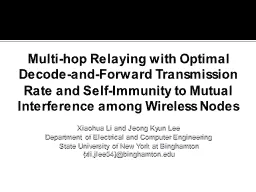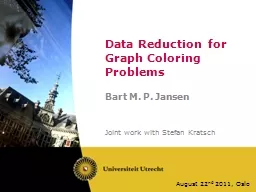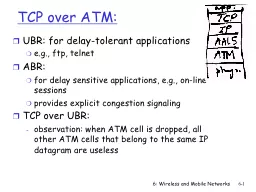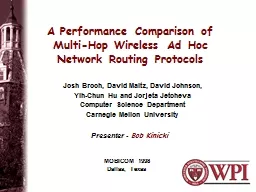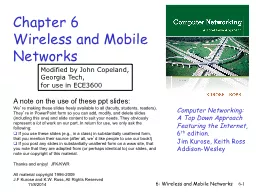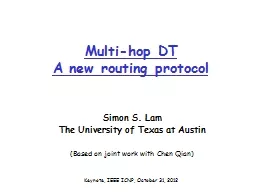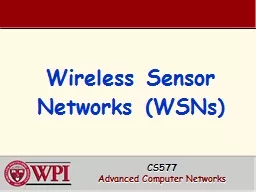PPT-Coloring Unstructured Wireless Multi-Hop Networks
Author : heartfang | Published Date : 2020-06-22
Johannes Schneider Roger Wattenhofer TexPoint fonts used in EMF Read the TexPoint manual before you delete this box A A A A Overview Motivation Model Illustration
Presentation Embed Code
Download Presentation
Download Presentation The PPT/PDF document "Coloring Unstructured Wireless Multi-Hop..." is the property of its rightful owner. Permission is granted to download and print the materials on this website for personal, non-commercial use only, and to display it on your personal computer provided you do not modify the materials and that you retain all copyright notices contained in the materials. By downloading content from our website, you accept the terms of this agreement.
Coloring Unstructured Wireless Multi-Hop Networks: Transcript
Johannes Schneider Roger Wattenhofer TexPoint fonts used in EMF Read the TexPoint manual before you delete this box A A A A Overview Motivation Model Illustration A simple algorithm. 6-. 1. Chapter 6. Wireless and Mobile Networks. Computer Networking: A Top Down Approach . 4. th. edition. . Jim Kurose, Keith Ross. Addison-Wesley, July 2007. . Computer Networking: A Top Down Approach . Xiaohua. Li and . Jeong. . Kyun. Lee. Department of Electrical and Computer Engineering . State University of New York at Binghamton . {xli,jlee54}@binghamton.edu . Major contributions. Develop efficient algorithm to construct optimal multi-hop path in arbitrarily large wireless networks. Bart M. P. Jansen. Joint work with Stefan . Kratsch. August 22. nd . 2011, Oslo. Vertex Coloring of Graphs. Given an undirected graph G and integer q, can we assign each vertex a color from {1, 2, …, q} such that adjacent vertices have different colors?. 6-. 1. TCP over ATM:. UBR: for delay-tolerant applications . e.g., ftp, telnet. ABR: . for delay sensitive applications, e.g., on-line sessions. provides explicit congestion signaling. TCP over UBR:. Presented by Dr Simon Whittock. This research was supported under Australian Research Council's . Linkage Projects. funding scheme (LP140100160).". Flavour: . the moment when what we put in our mouths and what we smell converge (. Communication . Networks. . Materials with thanks to Scott . Shenker. ,. . Jennifer Rexford, Ion . Stoica. , Vern . Paxson. and other colleagues at Princeton and UC Berkeley. Wireless. . – there is no cat!. Non-Fiction Project. African Bambaataa-”. Planet Rock”. Sugar Hill Gang-. ”Rappers Delight” . Run DMC-. ”King of Rock” . . Grand Master Flash-. Scratching DJ . Skull Coloring (front). Follow instructions on worksheet. Skull Coloring (back). Occipital – light green. Parietal – turquoise. Frontal – pink. Temporal – blue. Ethmoid. – brown. Sphenoid – gray. Johannes Schneider. Roger Wattenhofer. TexPoint fonts used in EMF. . Read the TexPoint manual before you delete this box.: . A. A. A. A. Overview. Motivation. Model. Illustration: A simple algorithm. Introduction. Jon Pollock. Senior Network Engineer. Glade Creek Technology. Wireless Concepts. Wireless networks are made of low frequency light. It can help to think of an Access Point as a light bulb. A Performance Comparison of Multi-Hop Wireless Ad Hoc Network Routing Protocols MOBICOM 1998 Dallas, Texas Josh Broch , David Maltz , David Johnson, Yih -Chun Hu and Jorjeta Jetcheva Computer 6-. 1. Chapter 6. Wireless and Mobile Networks. Computer Networking: A Top Down Approach Featuring the Internet. , . 6. th. . edition. . Jim Kurose, Keith Ross. Addison-. Wesley. A note on the use of these . Simon S. Lam. The University of Texas at Austin. (Based on joint work with Chen . Qian. ). Keynote, IEEE ICNP, October 31, 2012. Multi-hop DT (Simon S. . Lam. ). 2. Delaunay triangulation (DT)?. A set of point in 2D. CS577 . Advanced . Computer Networks . WSN Outline. Introduction. Mote Revolution. Wireless Sensor Network (WSN) Applications. WSN Details. Types of Wireless Sensor Networks (WSNs). Tiered Architectures.
Download Document
Here is the link to download the presentation.
"Coloring Unstructured Wireless Multi-Hop Networks"The content belongs to its owner. You may download and print it for personal use, without modification, and keep all copyright notices. By downloading, you agree to these terms.
Related Documents


